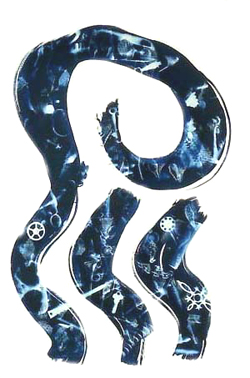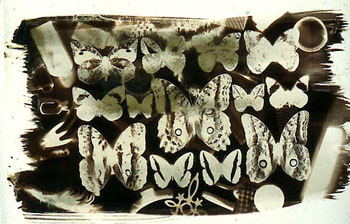While most photograms are made with
standard black and white photographic paper, the Photogram is a process
that lends itself to experimenting and in terms of materials, the
limiting factor is only one's imagination.
Alternative
photographic processes or hand made emulsions:
While alternative processes
like cyanotype, Van Dyke Brown, gum bichromate etc. are accessible
and popular there are a wide range that can be used to make photograms.
Albumen prints, Platinum/Palladium, salt prints, Daguerreotype etc.
can also be used.
They require a good knowledge of photography and chemistry as often
the chemicals have to mixed from scratch and applied onto a support
base like paper. This can be a fine printmaking paper, but it can
also include textiles, wood, and a range of other materials.
Many
of these processes require exposure to full sunlight for as
long as 20 min's and the direction of the light can vary during
this time, altering the shadows of taller objects. It has an
advantage in that the emulsion does not have to cover the entire
surface of the base and can be applied to form a motif. |

Cyanotype photogram
|
| |

Van Dyke
Brown
Chich'e
Verre photogram |
Children making simple cyanotype photograms at a workshop I ran in Blacon France in 2007 |
|
I
used both the Van Dyke Brown process and the Cyanotype for the Aporian
Emulsions project.